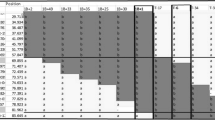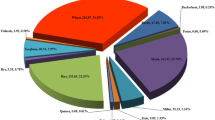Summary
The method of substitution and restoration of nucleus is briefly described.
Three species, Aegilops caudata, Ae. ovata and Triticum timopheevi, were used as donors of male sterility cytoplasms.
The characteristics of these three cytoplasms are summarized as follows:
Caudata-cytoplasm: This cytoplasm has in many respects deleterious effects on the manifestation of alien genomes. Substitution lines having hexaploid wheat genome constitution are mostly male sterile while the female organ is normal. Some lines set frequently germless seeds. Haploid and twin seedlings are of common occurrence in other lines. Pistillody is common in the substitution lines with tetraploid wheat genomes.
Ovata-cytoplasm: No pistillody was found in the substitution lines, both with hexaploid and tetraploid wheats. Male sterility is always complete in the substitution lines of hexaploid wheats with the exception of P 168, a variety of common wheat having a pair of satchromosomes of Ae. caudata. This variety restores male fertility completely. No effective restorers were found for the substitution lines of emmer wheat. Delayed heading is common in the 4x substitution lines.
Timopheevi-cytoplasm: Substitution lines of 6x wheats are mostly male sterile, while those of 4x wheats are more or less male fertile. Only the genome of T. spelta duhamelianum restores completely pollen fertility.
Among the indispensable factors for the success of hybrid wheat, five were discussed. They were (1) hetero sis, (2) selection of male sterile cytoplasms, (3) discovery of restoring genes, (4) production of hybrid seeds and (5) quality.
Zusammenfassung
Die Methode der Substitution und Restoration des Nucleus wird kurz beschrieben.
Drei Arten, Aegilops caudata, Ae. ovata und Triticum timopheevi, wurden als Donor cytoplasmatisch bedingter männlicher Sterilität verwendet. Die Charakteristika der jeweiligen Cytoplasmen lassen sich wie folgt zusammenfassen:
Caudata-Cytoplasma: Dieses Cytoplasma hat in vieler Hinsicht einen schädlichen Einfluß auf die Manifestation fremder Genome. Substitutionslinien mit einem hexaploiden Weizengenom sind meist männlich steril, das weibliche Organ ist normal. Einige Linien bringen häufig keimlose Samen; in anderen Linien treten haploide und Zwillingssamen auf. Bei Substitutionslinien mit tetraploiden Weizengenomen werden häufig andere Blütenorgane in Karpelle umgewandelt.
Ovata-Cytoplasma: In den Substitutionslinien sowohl der hexaploiden wie tetraploiden Weizen wurden keine anderen Blütenorgane in Karpelle umgewandelt. Die Substitutionslinien der hexaploiden Weizen sind stets vollkommen männlich steril mit Ausnahme von P 168, einer Weizenvarietät, die ein Paar Sat-Chromosomen von Ae. caudata besitzt. Diese Varietät stellt die männliche Fertilität vollkommen wieder her. In den Emmer-Substitutionslinien wurden keine wirksamen Restorer gefunden. Bei den 4x-Substitutionslinien zeigt sich häufig verzögertes Ährenschieben.
Timopheevi-Cytoplasma: Die Substitutionslinien der 6x-Weizen sind meist männlich steril, die von 4x-Weizen dagegen mehr oder weniger männlich fertil. Nur das Genom von T. spelta duhamelianum stellt die Pollenfertilität völlig wieder her.
Von den für den Erfolg der Hybridweizenzüchtung unabdingbaren Faktoren wurden die folgenden 5 besprochen: 1. Heterosis, 2. Selektion männliche Sterilität bedingender Cytoplasmen, 3. Auffinden von Restorergenen, 4. Produktion von Hybridsaatgut und 5. Qualität.
Similar content being viewed by others
Literature
Fukasawa, H.: Studies on restoration and substitution of nucleus of Aegilotricum, I. Appearance of malesterile durum in substitution crosses. Cytologia 18, 167–175 (1953).
Fukasawa, H.: Nucleus substitution and restoration by means of successive backcrosses in wheat and its related genus Aegilops. Jap. Jour. Bot. 17, 55–91 (1959).
Johnson, V. A.: Hybrid wheat investigations in the United States. Paper presented at the International Symposium on “Improvement of plants against hunger in the world”, Paris (1966a).
Johnson, V. A.: Agronomic and quality implications of hybrid wheat. Paper presented at the 4th International Cereal and Bread Congress, Wien (1966b).
Kihara, H.: Advances in the genome-analysis in Triticum. Botanical papers dedicated to Professor Kingo Miyabe in celebration of his 90th birthday, 42–55 (1949).
Kihara, H.: Substitution of nucleus and its effects on genome manifestations. Cytologia 16, 177–193 (1951).
Kirara, H.: Nucleus and chromosome substitution in wheat and Aegilops, II. Chromosome substitution. Seiken Zihô 15, 13–23 (1963).
Kihara, H.: Nucleus and chromosome substitution in wheat and Aegilops. I. Nucleus substitution. Proc. II International Wheat Genetics Symposium, in press (1964).
Kihara, H., and M. Muramatsu: A supernumerary trabant chromosome in one substitution wheat strain and its manifestation, I. Japan. J. Genetics 30, 173 (1955).
Kihara, H., and K. Tsunewaki: Use of an alien cytoplasm as a new method of producing haploids. Japan. J. Genetics 37, 310–313 (1962).
Kihara, H., and K. Tsunewaki: Increased occurrence of haploids and twin seedlings due to an alien cytoplasm. Wheat Information Service 15–16, 32–34 (1963).
Kihara, H., and K. Tsunewaki: Some fundamental problems underlying the program for hybrid wheat breeding. Seiken Zihô 16, 1–14 (1964).
Kihara, H., and K. Tsunewaki: Genetic principles applied to the breeding of crop plants. The Heritage from Mendel. University of Wisconsin Press (In press).
Kimura, M.: The theory of the chromosome substitution between two different species. Cytologia 15, 281–294 (1950).
Lilienfeld, F. A., und H. Kihara. Genomanalyse bei Triticum und Aegilops. V. Triticum timopheevi Zhuk. Cytologia 6, 87–122 (1934).
Muramatsu, M.: Homology of chromosomes of Aegilops caudata with common wheat. Wheat Information Service 9–10, 32–33 (1959).
Percival, J.: The wheat plant. A monograph. London: Duckworth 1921.
Tsunewaki, K.: Analysis of the fertility-restoring gene in Triticum aestivum ssp. compactum. Seiken Zihô 15, 47–53 (1963).
Tsunewaki, K.: Genetic studies of a 6x-derivative from an 8x Triticale. Can. J. Genet. Cytol. 6, 1–11 (1964).
Wilson, J. A., and W. M. Ross: Cross-Breeding in wheat, Triticum aestivum. II. Crop Sci 2, 415–417 (1962).
Author information
Authors and Affiliations
Additional information
Dedicated to Professor Hans Stubbe on the occasion of his 65th birthday.
Contribution from the National Institute of Genetics, Japan, No. 636. This paper has been prepared for a lecture delivered July 18, 1966, at the Lenin All-Union Academy of Agricultural Science. This work has been supported by the Rockefeller Foundation, Grant GA AGR 65111.
Rights and permissions
About this article
Cite this article
Kihara, H. Cytoplasmic male sterility in relation to hybrid wheat breeding. Zuchter \ Genet. Breed. Res. 37, 86–93 (1967). https://doi.org/10.1007/BF00329572
Issue Date:
DOI: https://doi.org/10.1007/BF00329572




